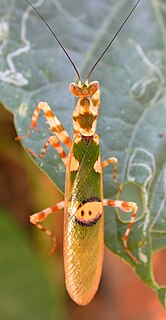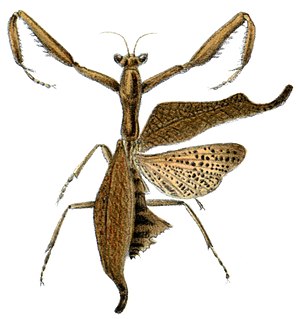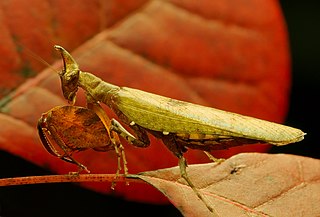Related Research Articles

Creobroter is a genus of flower mantises in the tribe Hymenopodini; species are concentrated in Asia. The name comes from the Greek kreo-, meaning "flesh") and broter" meaning "eating", therefore, "flesh-eating", an apt name for a predatory insect. Both sexes have long wings and are capable fliers. Full-grown males are about 3 to 4 cm in length; females are about 4 to 5 cm.

Flower mantises are those species of praying mantises that mimic flowers. Their coloration is an example of aggressive mimicry, a form of camouflage in which a predator's colours and patterns lure prey. The flower mantises are not a natural group with a single ancestor, but most of the species are in the family Hymenopodidae. Their behaviours vary, but typically involve climbing a plant, and then staying still until a prey insect comes within range. Many species of flower mantises are popular as pets.

Choeradodis is a genus of praying mantises with common names such as shield mantis, hood mantis, and leaf mantis because of their extended, leaf-like thoraces. The distinguishing characteristic of Choreododis from which it takes its common names is a laterally expanded thorax. This adaptation for the purpose of camouflage, as well as a rounded wing case and a habit of staying relatively flattened, aid its leaf mimicry.

Dead leaf mantis is a common name given to various species of praying mantis that mimic dead leaves. It is most often used in reference to species within genus Deroplatys because of their popularity as exotic pets. Examples include D. desiccata, D. lobata, and D. philippinica. Other species to which the term may apply include Acanthops falcataria, A. falcata, and Phyllocrania paradoxa.

Acanthops falcataria, common name South American dead leaf mantis, is a species of praying mantis in the family Acanthopidae. It is not to be confused with Acanthops falcata, a different species in the same genus that is often referred to with the same common name.
Grass mantis is a common name mostly given to various species of praying mantis that mimic grass or other slender vegetation. Species to which this name has been applied include but are not limited to:

Sphodromantis is a large genus of praying mantises concentrated in Africa, sometimes considered a synonym of the genus Hierodula: from the same tribe, Paramantini. Outside their range especially, many share the common name African Mantis.

Acromantis japonica, common name Japanese boxer mantis, is a species of praying mantis found in Japan, Korea, Taiwan, and China. It was described by John Obadiah Westwood in 1889. Acromantis japonica belongs to the family Hymenopodidae and subfamily Acromantinae. No subspecies are listed.
Acromantis gestri, common name Sumatran Acromantis or Thailand boxer praying mantis, is a species of praying mantis found in Malaysia and Sumatra.
Acromantis philippina, common name Philippines acromantis, is a species of praying mantis native to the Philippines.
Acromantis montana, common name mountain acromantis, is a species of praying mantis found in India, Java, and Borneo.
Acromantis elegans, common name elegant acromantis, is a species of praying mantis native to Nepal.

Choeradodis stalii is a species of praying mantis with common names that include tropical shield mantis, hooded mantis, and leaf mantis. It is found in Brazil, Ecuador, French Guiana, Panama, and Peru.

Rhombodera is a genus of praying mantises native to Asia and possessing common names such as shield mantis, hood mantis, and leaf mantis because of their extended, leaf-like thoraxes.

Bark mantis is a common name given to various species of praying mantis, especially those with cryptic camouflage resembling tree bark. Examples include:

Hestiasula is a genus of Asian praying mantids in the subfamily Oxypilinae of the family Hymenopodidae.
Acanthops falcata, common name South American dead leaf mantis or boxer mantis, is a species of praying mantis in the subfamily Acanthopinae of the family Acanthopidae and is one of many praying mantises from various genera that resembles a dead leaf.

Mantises are an order (Mantodea) of insects that contains over 2,400 species in about 460 genera in 33 families. The largest family is the Mantidae ("mantids"). Mantises are distributed worldwide in temperate and tropical habitats. They have triangular heads with bulging eyes supported on flexible necks. Their elongated bodies may or may not have wings, but all Mantodea have forelegs that are greatly enlarged and adapted for catching and gripping prey; their upright posture, while remaining stationary with forearms folded, has led to the common name praying mantis.

Acromantini is a tribe of mantis in the family Hymenopodidae, which contains 9 genera and 35 species:
References
- ↑ Alien Insect: Praying Mantis, 2004, by Discovery Channel.
- ↑ Thailand Boxer Praying Mantis - Acromantis gestri
- ↑ "List on mantises and common names". Archived from the original on 2008-06-17. Retrieved 2008-07-29.
- ↑ "Synonym Oxypilus (Oxypilus) distinctus Beier, 1930: Mantodea Species File".
- ↑ "Oxypilus distinctus". Archived from the original on 2008-06-17. Retrieved 2008-07-29.